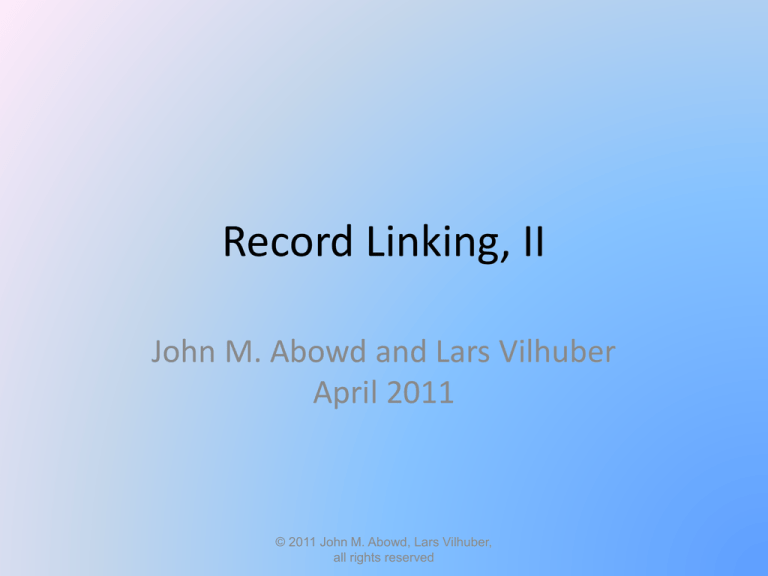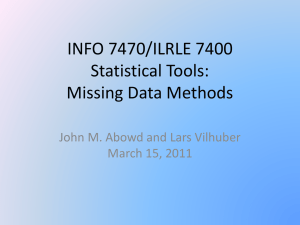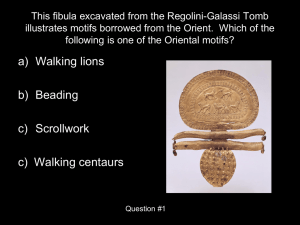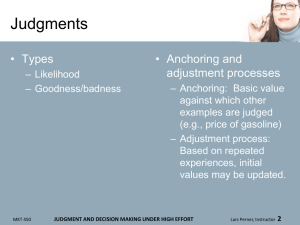
Record Linking, II
John M. Abowd and Lars Vilhuber
April 2011
© 2011 John M. Abowd, Lars Vilhuber,
all rights reserved
Implementing Probabilistic
Record Linkage
•
•
•
•
•
•
•
•
Standardizing
Blocking and matching variables
Calculating the agreement index
Choosing M and U probabilities
Estimating M and U probabilities using EM
Clerical editing
Estimating the false match rate
Estimating the false nonmatch rate
2011-04-05
© 2011 John M. Abowd, Lars Vilhuber,
all rights reserved
Matching Software
• Commercial ($$$$-$$$$$)
– Automatch/Vality/Ascential/IBM WebSphere Information
Integration
(grew out of Jaro’s work at the Census Bureau)
– DataFlux/ SAS Data Quality Server
– Oracle
– Others
• Custom software (0-$$)
– C/Fortran Census SRD-maintained software
– Java implementation used in Domingo-Ferrer, Abowd, and
Torra (2006)
– Java Data Mining API
2011-04-05
© 2011 John M. Abowd, Lars Vilhuber,
all rights reserved
Software differences
• Each software is an empirical/practical
implementation driven by specific needs
• Terminology tends to differ:
– “standardize”, “schema”, “simplify”
– “block”, “exact match”
– “comparator function”, “match definition”
2011-04-05
© 2011 John M. Abowd, Lars Vilhuber,
all rights reserved
Standardizing
Custom/
Vality/Ascent SAS DQ
SRD
ial
PROC DQSCHEME
standard Yes
Blocking and matching
variables
Yes
Yes
Yes (blocking =
“exact match”)
Calculating the
agreement index
Yes
Yes
No
Choosing M and U
probabilities
Yes
Yes
No
Estimating M and U
probabilities using EM
Yes (eci)
(external)
No
Matching
matcher
Yes
PROC DQMATCH
(varying “sensitivity” achieves the
same goal)
2011-04-05© 2011 John M. Abowd, Lars Vilhuber, all rights reserved
STANDARDIZING
2011-04-05
© 2011 John M. Abowd, Lars Vilhuber,
all rights reserved
Standardizing
• Standardization is a necessary preprocessing step for
all data to be linked via probabilistic record linking
• A standardizer:
– Parses text fields into logical components (first name, last
name; street number, street name, etc.)
– Standardizes the representation of each parsed field
(spelling, numerical range, capitalization, etc.)
• Commercial standardizers have very high valueadded compared to home-grown standardizers but
are very expensive
2011-04-05
© 2011 John M. Abowd, Lars Vilhuber,
all rights reserved
How to Standardize
•
•
•
•
•
Inspect the file to refine strategy
Use commercial software
Write custom software (SAS, Fortran, C)
Apply standardizer
Inspect the file to refine strategy
2011-04-05
© 2011 John M. Abowd, Lars Vilhuber,
all rights reserved
Standardizing Names
Alternate spellings
1.
2.
3.
4.
5.
2011-04-05
Dr. William J. Smith, MD
Bill Smith
W. John Smith, MD
W.J. Smith, Jr.
Walter Jacob Smith, Sr.
© 2011 John M. Abowd, Lars Vilhuber,
all rights reserved
Standardized Names
1
Pre
First
Mid
Last
Pos
t1
Dr
William
J
Smith
MD
Post
2
Alt1
Std1
BWILL
2
Bill
Smith
William
3
W
John
Smith
4
W
J
Smith
Jr
4
Walter
Jacob
Smith
Sr
BWILL
MD
2011-04-05© 2011 John M. Abowd, Lars Vilhuber, all rights reserved
WALT
Standardizing Addresses
Many different pieces of information
1. 16 W Main Street #16
2. RR 2 Box 215
3. Fuller Building, Suite 405, 2nd door to
the right
4. 14588 Highway 16W
2011-04-05
© 2011 John M. Abowd, Lars Vilhuber,
all rights reserved
Standardized Addresses
1
Pre
2
Hsnm
Stnm
W
16
Main
2
RR
Box
Post1
Post2
St
2
14588
Hwy
Unit
2
Bldg
405
Fuller
16
215
3
4
Unit
1
16
2011-04-05© 2011 John M. Abowd, Lars Vilhuber, all rights reserved
W
Standardizing and language
• Standardizers are language- and “country”specific
– Address tokens may differ: “street”, “rue”, “calle”,
“Straße”
– Address components may differ:
• 123 Main Street
Normal, IL 61790
• L 7,1
D-68161 Mannheim
• 1234 URB LOS OLMOS
PONCE PR 00731-1235
2011-04-05
© 2011 John M. Abowd, Lars Vilhuber,
all rights reserved
Standardizing and language (2)
• Names differ
– Juan, John, Johann, Yohan
• Variations of names differ:
– Sepp, Zé, Joe -> Joseph
• Frequencies of names differ (will be important
later)
– Juan is frequent in Mexico, infrequent in Germany
2011-04-05
© 2011 John M. Abowd, Lars Vilhuber,
all rights reserved
Custom standardization
• Standardization may depend on the particular
application
• Example OPM project
– “Department of Defense”
– “Department of Commerce”
– The token “Department of” does not have
distinguishing power, but comprises the majority
of the “business name”
– Similar: “Service”, “Bureau”
2011-04-05
© 2011 John M. Abowd, Lars Vilhuber,
all rights reserved
MATCHING
2011-04-05
© 2011 John M. Abowd, Lars Vilhuber,
all rights reserved
Implementing the Basic Matching
Methodology
• Identifying comparison strategies:
–
–
–
–
Which variables to compare
String comparator metrics
Number comparison algorithms
Search and blocking strategies
• Ensuring computational feasibility of the task
– Choice of software/hardware combination
– Choice of blocking variables (runtimes quadratic in size of
block)
• Estimating necessary parameters
2011-04-05
© 2011 John M. Abowd, Lars Vilhuber,
all rights reserved
Determination of Match Variables
• Must contain relevant information
• Must be informative (distinguishing power!)
• May not be on original file, but can be
constructed (frequency, history information)
2011-04-05
© 2011 John M. Abowd, Lars Vilhuber,
all rights reserved
Blocking and Matching
• The essence of a probabilistic record link is iterating passes of
the data files in which blocking variables (must match exactly)
and matching variables (used to compute the agreement
index) change roles.
• Blocking variables reduce the computational burden but
increase the false non-match rate => solved by multiple
passes
• As records are linked, the linked records are removed from
the input files and the analyst can use fewer blocking
variables to reduce the false non-matches.
• Matching variables increase the computational burden and
manage the tradeoff between false match and false nonmatch errors
2011-04-05
© 2011 John M. Abowd, Lars Vilhuber,
all rights reserved
SSN Name Editing
Example
Separations
too high
Coded
Name
Lesli Kay
Leslie Kay
Lesly Kai
Coded
SSN
1
2/ 1
3/ 1
EIN
Earnings
A $10
A $10
B $11
1’s tenure with A:
1’s employment history
2011-04-05
© 2011 John M. Abowd, Lars Vilhuber,
all rights reserved
Accessions
too high
SSN Name Editing
Example
Separations
too high
Coded
Name
Lesli Kay
Leslie Kay
Lesly Kai
Coded
SSN
1
2
3
EIN
Accessions
too high
Earnings
A $10
A $10
B $11
T(1) T(2) T(3)
2011-04-05
© 2011 John M. Abowd, Lars Vilhuber,
all rights reserved
Computed and observed variables
• Reclassification of information
• Blocking on a-priori information
File
Name
SSN
Earn
Period
Gender
Type
A
Lesli Kay
1
$10
T(2)
M
Hole
B
Leslie Kay
2
$10
T(2)
M
Plug
B
Lesly Kai
3
$10
T(4)
F
Plug
• Blocking: Earn, Period, Gender
• Match on: Name, SSN
2011-04-05© 2011 John M. Abowd, Lars Vilhuber, all rights reserved
Iterating
• First pass may block on a possibly miscoded
variable
File
Name
SSN
Earn
Period
Gender
Type
A
Lesli Kay
1
$10
T(2)
M
Hole
B
Leslie Kay
2
$10
T(2)
M F
Plug
B
Lesly Kai
3
$10
T(4)
F
Plug
• Block pass 1: Earn, Period, Gender
• Block pass 2: Earn, Period
2011-04-05© 2011 John M. Abowd, Lars Vilhuber, all rights reserved
Understanding Comparators
• Comparators need to account for
– Typographical error
– Significance of slight variations in numbers (both
absolute and relative)
– Possible variable inversions (first and last name
flipped)
2011-04-05
© 2011 John M. Abowd, Lars Vilhuber,
all rights reserved
Soundex: History
• Used for historical analysis, archiving
• Origins in early 20th century
• Available in many computer programs (SQL,
SAS, etc.)
• Official “American” Soundex at National
Archives:
http://www.archives.gov/research/census/soundex.html
2011-04-05
© 2011 John M. Abowd, Lars Vilhuber,
all rights reserved
String Comparators: Soundex
• The first letter is copied unchanged
• Subsequent letters:
bfpv -> "1"
dt -> "3"
mnñ -> "5"
cgjkqsxzç -> "2"
l -> "4"
r -> "6 "
• Other characters are ignored
• Repeated characters treated as single character.
• 4 chars, zero padded.
• For example, "SMITH" or "SMYTHE" would both be encoded
as "S530".
2011-04-05
© 2011 John M. Abowd, Lars Vilhuber,
all rights reserved
String Comparators: Jaro
• First returns a value based on counting
insertions, deletions, transpositions, and
string length
• Total agreement weight is adjusted downward
towards the total disagreement weight by
some factor based on the value
• Custom adjustments (Winkler and others)
2011-04-05
© 2011 John M. Abowd, Lars Vilhuber,
all rights reserved
Comparing Numbers
• A difference of “34” may mean different
things:
– Age: a lot (mother-daughter? Different person)
– Income: little
– SSN or EIN: no meaning
• Some numbers may be better compared using
string comparators
2011-04-05
© 2011 John M. Abowd, Lars Vilhuber,
all rights reserved
Number of Matching Variables
• In general, the distinguishing power of a
comparison increases with the number of
matching variables
• Exception: variables are strongly correlated,
but poor indicators of a match
• Example: General business name and legal
name associated with a license.
2011-04-05
© 2011 John M. Abowd, Lars Vilhuber,
all rights reserved
Determination of Match Parameters
• Need to determine the conditional probabilities
P(agree|M), P(agree|U) for each variable
comparison
• Methods:
–
–
–
–
–
Clerical review
Straight computation (Fellegi and Sunter)
EM algorithm (Dempster, Laird, Rubin, 1977)
Educated guess/experience
For P(agree|U) and large samples (population): computed
from random matching
2011-04-05
© 2011 John M. Abowd, Lars Vilhuber,
all rights reserved
Determination of Match Parameters
(2)
• Fellegi & Sunter provide a solution when γ
represents three variables. The solution can
be expressed as marginal probabilities mk and
uk
• In practice, this method is used in many
software applications
• For k>3, method-of-moments or EM methods
can be used.
2011-04-05
© 2011 John M. Abowd, Lars Vilhuber,
all rights reserved
Calculating the Agreement Index
• We need to compute P(γ|M), P(γ|U) and the agreement ratio
R(γ) = P(γ|M) / P(γ|U)
• The agreement index is ln R(γ).
• The critical assumption is conditional independence:
P(γ|M) = P(γ1|M) P(γ2|M)… P(γK|M)
P(γ|U) = P(γ1|U) P(γ2|U)… P(γK|U)
where the subscript indicates an element of the vector γ.
• Implies that the agreement index can be written as:
P k | M
ln R ln
P
|
U
k 1
k
K
2011-04-05© 2011 John M. Abowd, Lars Vilhuber, all rights reserved
Choosing m and u Probabilities
• Define
mk = P(γk|M)
uk = P(γk|U)
• These probabilities are often assessed using a priori
information or estimated from an expensive clerically
edited link.
– m often set a priori to 0.9
– u often set a priori to 0.1
• Neither of these assumptions has much empirical
support
2011-04-05
© 2011 John M. Abowd, Lars Vilhuber,
all rights reserved
Some Rules of Thumb
• Gender
mk = P(γk|M) is a function of the data (random miscodes of
gender variable)
uk = P(γk|U) = 0.5 (unconditional on other variables). This
may not be true for certain blocking variables: age, veteran
status, etc. will affect this value
• Exact identifiers (SSN, SIN)
mk = P(γk|M) will depend on verification by the data provider.
For example, embedded checksums will move this
probability closer to 1.
uk = P(γk|U) << 0.1
2011-04-05
© 2011 John M. Abowd, Lars Vilhuber,
all rights reserved
Marginal Probabilities: Educated
Guesses for Starting Values
• P(agree on characteristic X| M)=
0.9 if X = first, last name, age
0.8 if X = house no., street name, other characteristic
• P(agree on characteristic X| U)=
0.1 if X = first, last name, age
0.2 if X = house no., street name, other characteristic
Note that distinguishing power of first name
(R(first)=0.9/0.1=9) is larger than the street name
(R(street)=0.8/0.2=4)
2011-04-05
© 2011 John M. Abowd, Lars Vilhuber,
all rights reserved
2011-04-05
© 2011 John M. Abowd, Lars Vilhuber,
all rights reserved
Marginal Probabilities:
Better Estimates of P(agree|M)
• P(agree|M) can be improved after a first
match pass by a clerical review of match pairs:
– Draw a sample of pairs
– Manual review to determine “true” match status
– Recompute P(agree|M) based on known truth
sample
2011-04-05
© 2011 John M. Abowd, Lars Vilhuber,
all rights reserved
Estimating m and u Using Matched Data
• If you have two files a
and b that have already
mˆ k
been linked (perhaps
clerically, perhaps with
an exact link) then
these estimates are
uˆ k
available:
a , b 1
a , b L
k
1a , b L
a ,b
a , b 1
a , b U
k
1a , b U
a ,b
where a a , b b , a , b .
2011-04-05© 2011 John M. Abowd, Lars Vilhuber, all rights reserved
Estimating m and u Probabilities Using EM
• Based on Winkler 1988 "Using the EM Algorithm for Weight
Computation in the Fellegi-Sunter Model of Record Linkage," Proceedings of the
Section on Survey Research Methods, American Statistical Association, 667-671.
• Uses the identity
P()=P(|M)P(M)+P(|U)P(U)
• Imposes conditional independence
2011-04-05
© 2011 John M. Abowd, Lars Vilhuber,
all rights reserved
Clerical Editing
• Once the m and u probabilities have been
estimated, cutoffs for the U, C, and L sets must
be determined.
• This is usually done by setting preliminary
cutoffs then clerically refining them.
• Often the m and u probabilities are tweaked
as a part of this clerical review.
2011-04-05
© 2011 John M. Abowd, Lars Vilhuber,
all rights reserved
Estimating the False Match Rate
• This is usually done by clerical review of a run
of the automated matcher.
• Some help is available from Belin, T. R., and
Rubin, D. B. (1995), "A Method for Calibrating
False-Match Rates in Record Linkage," Journal
of the American Statistical Association, 90,
694-707.
2011-04-05
© 2011 John M. Abowd, Lars Vilhuber,
all rights reserved
Estimating the False Nonmatch Rate
• This is much harder.
• Often done by a clerical review of a sample of the
non-match records.
• Since false nonmatching is relatively rare among the
nonmatch pairs, this sample is often stratified by
variables known to affect the match rate.
• Stratifying by the agreement index is a very effective
way to estimate false nonmatch rates.
2011-04-05
© 2011 John M. Abowd, Lars Vilhuber,
all rights reserved
Post-processing
• Once matching software has identified
matches, further processing may be needed:
– Clean up
– Carrying forward matching information
– Reports on match rates
2011-04-05
© 2011 John M. Abowd, Lars Vilhuber,
all rights reserved
Example: Abowd and Vilhuber (2005)
• 'The Sensitivity of Economic Statistics to Coding
Errors in Personal Identifiers‘, Journal of Business
and Economic Statistics, 23(2), pages 133-152
• Goal of the study: Assess the impact of
measurement error in tenure on aggregate
measures of turnover
• http://www.jstor.org/stable/27638803
• Appendix A has a detailed description of
matching passes and construction of additional
blocking variables
2011-04-05
© 2011 John M. Abowd, Lars Vilhuber,
all rights reserved
Example: CPS-Decennial 2000 match
• “Accuracy of Data for Employment Status as
Measured by the CPS-Census 2000 Match”,
Palumbo and Siegel (2004), Census 2000
Evaluation B.7, accessed at
http://www.census.gov/pred/www/rpts/B.7%
20Final%20Report.pdf on April 5, 2011.
• Goal of the study: assess employment status
on two independent questionnaires.
2011-04-05
© 2011 John M. Abowd, Lars Vilhuber,
all rights reserved
Software notes
• Idiosyncratic implementations
– Merge two files in Stata/SAS/SQL/etc. (outer join
or wide file), within blocks
– For given m/u, compute agreement index on a
per-variable basis for all
– Order records within blocks, select match record
– Generically, this works with numeric variables, but
has issues when working with character variables
• Typically, only Soundex available
• Implementing string comparators (Jaro) may be difficult
2011-04-05
© 2011 John M. Abowd, Lars Vilhuber,
all rights reserved
Software notes: character matching
• SAS Data Quality
– Is focused on “data quality”, “data cleaning”
– Has functions for standardization and string matching
– String matching is variant of Soundex: simplified
strings based on generic algorithms
– Issues: no probabilistic foundation, useful primarily for
sophisticated string matching
• Combination of SAS DQ and idiosyncratic
processing can yield powerful results
2011-04-05
© 2011 John M. Abowd, Lars Vilhuber,
all rights reserved
Software notes: SQL
• SQL languages are used in many contexts
where matching is frequent
– Oracle 10g R1 has Jaro-Winkler edit-distance
implemented.
– MySQL allows for some integration (possibly see
http://androidaddicted.wordpress.com/2010/06/01/jaro-winkler-sqlcode/ )
– PostGreSQL add-ons
http://pgsimilarity.projects.postgresql.org/
2011-04-05
© 2011 John M. Abowd, Lars Vilhuber,
all rights reserved
Software notes: R
• R has a recent package (untested by us) that
seems a fairly complete suite
http://journal.r-project.org/archive/2010-2/RJournal_2010-2_Sariyar+Borg.pdf
• Does not include standardization
2011-04-05
© 2011 John M. Abowd, Lars Vilhuber,
all rights reserved
Acknowledgements
•
•
•
This lecture is based in part on a 2000 lecture given by William Winkler, William Yancey and
Edward Porter at the U.S. Census Bureau
Some portions draw on Winkler (1995), “Matching and Record Linkage,” in B.G. Cox et. al.
(ed.), Business Survey Methods, New York, J. Wiley, 355-384.
Examples are all purely fictitious, but inspired by true cases presented in the above lecture, in
Abowd & Vilhuber (2005).
2011-04-05
© 2011 John M. Abowd, Lars Vilhuber,
all rights reserved










